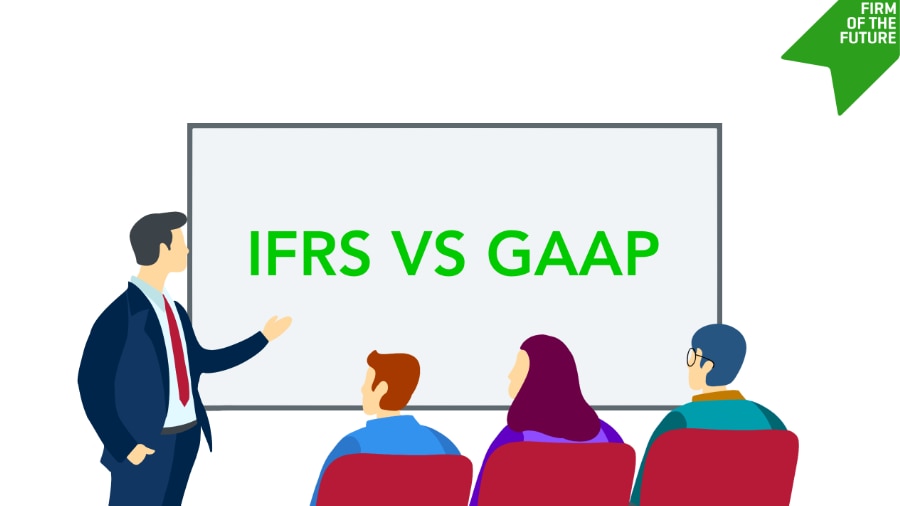We live in an increasingly global economy, so it’s important for business owners and accounting professionals to be aware of the differences between the two predominant accounting methods used around the world. International Financial Reporting Standards (IFRS) – as the name implies – is an international standard developed by the International Accounting Standards Board (IASB). U.S. Generally Accepted Accounting Principles (GAAP) is only used in the United States. GAAP is established by the Financial Accounting Standards Board (FASB).
Let’s look at the 10 biggest differences between IFRS and GAAP accounting.
#1: Local vs. Global
IFRS is used in more than 110 countries around the world, including the EU and many Asian and South American countries. GAAP, on the other hand, is only used in the United States. Companies that operate in the U.S. and overseas may have more complexities in their accounting.
#2: Rules vs. Principles
GAAP tends to be more rules-based, while IFRS tends to be more principles-based. Under GAAP, companies may have industry-specific rules and guidelines to follow, while IFRS has principles that require judgment and interpretation to determine how they are to be applied in a given situation.
However, convergence projects between FASB and IASB have resulted in new GAAP and IFRS standards that share more similarities than differences. For example, the recent GAAP standard for revenue from contracts with customers, Auditing Standards Update (ASU) No. 2014-09 (Topic 606) and the corresponding IFRS standard, IFRS 15, share a common principles-based approach.
#3: Inventory Methods
Both GAAP and IFRS allow First In, First Out (FIFO), weighted-average cost, and specific identification methods for valuing inventories. However, GAAP also allows the Last In, First Out (LIFO) method, which is not allowed under IFRS. Using the LIFO method may result in artificially low net income and may not reflect the actual flow of inventory items through a company.
#4: Inventory Write-Down Reversals
Both methods allow inventories to be written down to market value. However, if the market value later increases, only IFRS allows the earlier write-down to be reversed. Under GAAP, reversal of earlier write-downs is prohibited. Inventory valuation may be more volatile under IFRS.
#5: Fair Value Revaluations
IFRS allows revaluation of the following assets to fair value if fair value can be measured reliably: inventories, property, plant & equipment, intangible assets, and investments in marketable securities. This revaluation may be either an increase or a decrease to the asset’s value. Under GAAP, revaluation is prohibited except for marketable securities.
#6: Impairment Losses
Both standards allow for the recognition of impairment losses on long-lived assets when the market value of an asset declines. When conditions change, IFRS allows impairment losses to be reversed for all types of assets except goodwill. GAAP takes a more conservative approach and prohibits reversals of impairment losses for all types of assets.
#7: Intangible Assets
Internal costs to create intangible assets, such as development costs, are capitalized under IFRS when certain criteria are met. These criteria include consideration of the future economic benefits.
Under GAAP, development costs are expensed as incurred, with the exception of internally developed software. For software that will be used externally, costs are capitalized once technological feasibility has been demonstrated. If the software will only be used internally, GAAP requires capitalization only during the development stage. IFRS has no specific guidance for software.
#8: Fixed Assets
GAAP requires that long-lived assets, such as buildings, furniture and equipment, be valued at historic cost and depreciated appropriately. Under IFRS, these same assets are initially valued at cost, but can later be revalued up or down to market value. Any separate components of an asset with different useful lives are required to be depreciated separately under IFRS. GAAP allows for component depreciation, but it is not required.
#9: Investment Property
IFRS includes the distinct category of investment property, which is defined as property held for rental income or capital appreciation. Investment property is initially measured at cost, and can be subsequently revalued to market value. GAAP has no such separate category.
#10: Lease Accounting
While the approaches under GAAP and IFRS share a common framework, there are a few notable differences. IFRS has a de minimus exception, which allows lessees to exclude leases for low-valued assets, while GAAP has no such exception. The IFRS standard includes leases for some kinds of intangible assets, while GAAP categorically excludes leases of all intangible assets from the scope of the lease accounting standard.
Understanding these differences between IFRS and GAAP accounting is essential for business owners operating internationally. Investors and other stakeholders need to be aware of these differences so they can correctly interpret financials under either standard.
Editor’s note: This article was updated with new content on Jan. 21, 2020.
